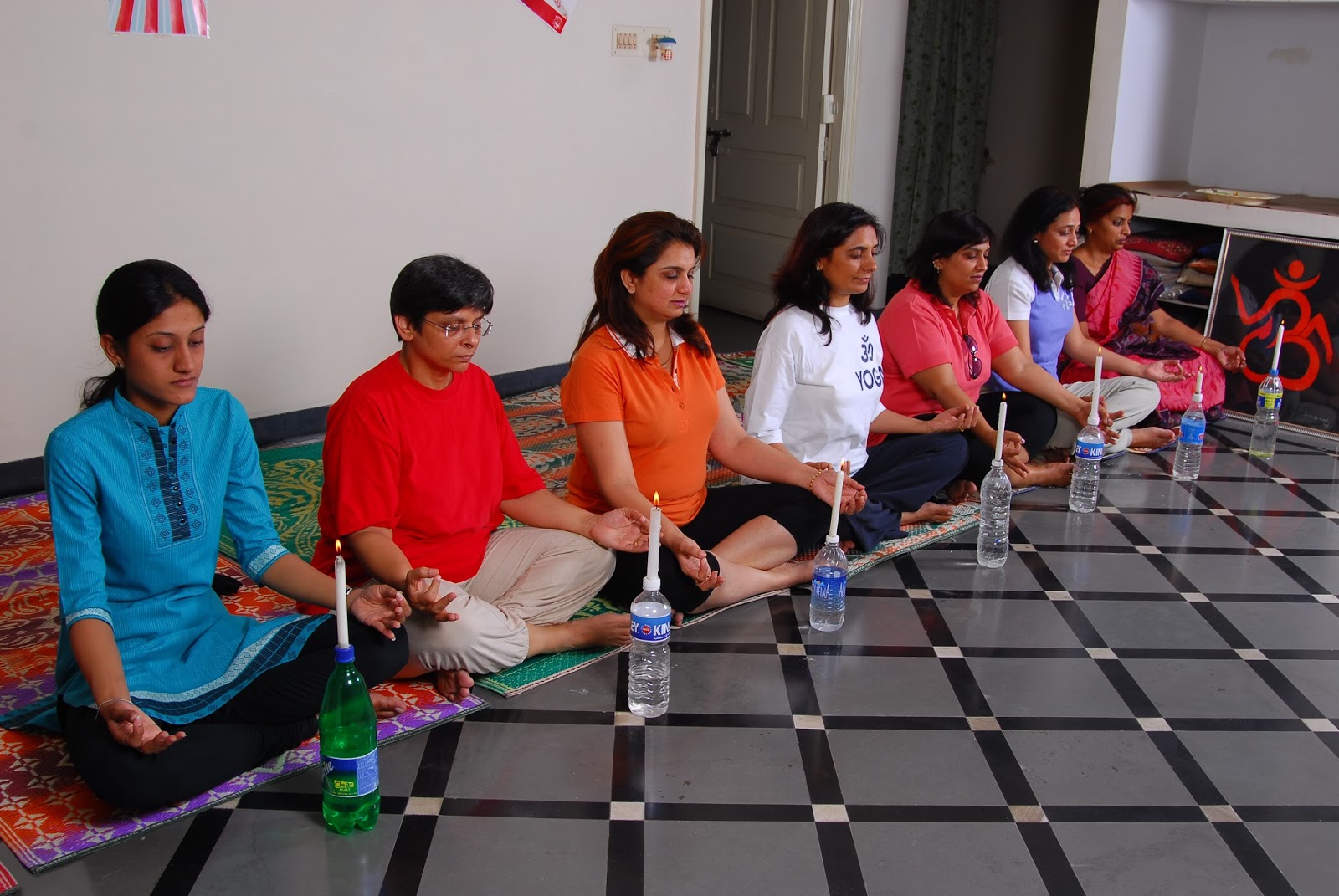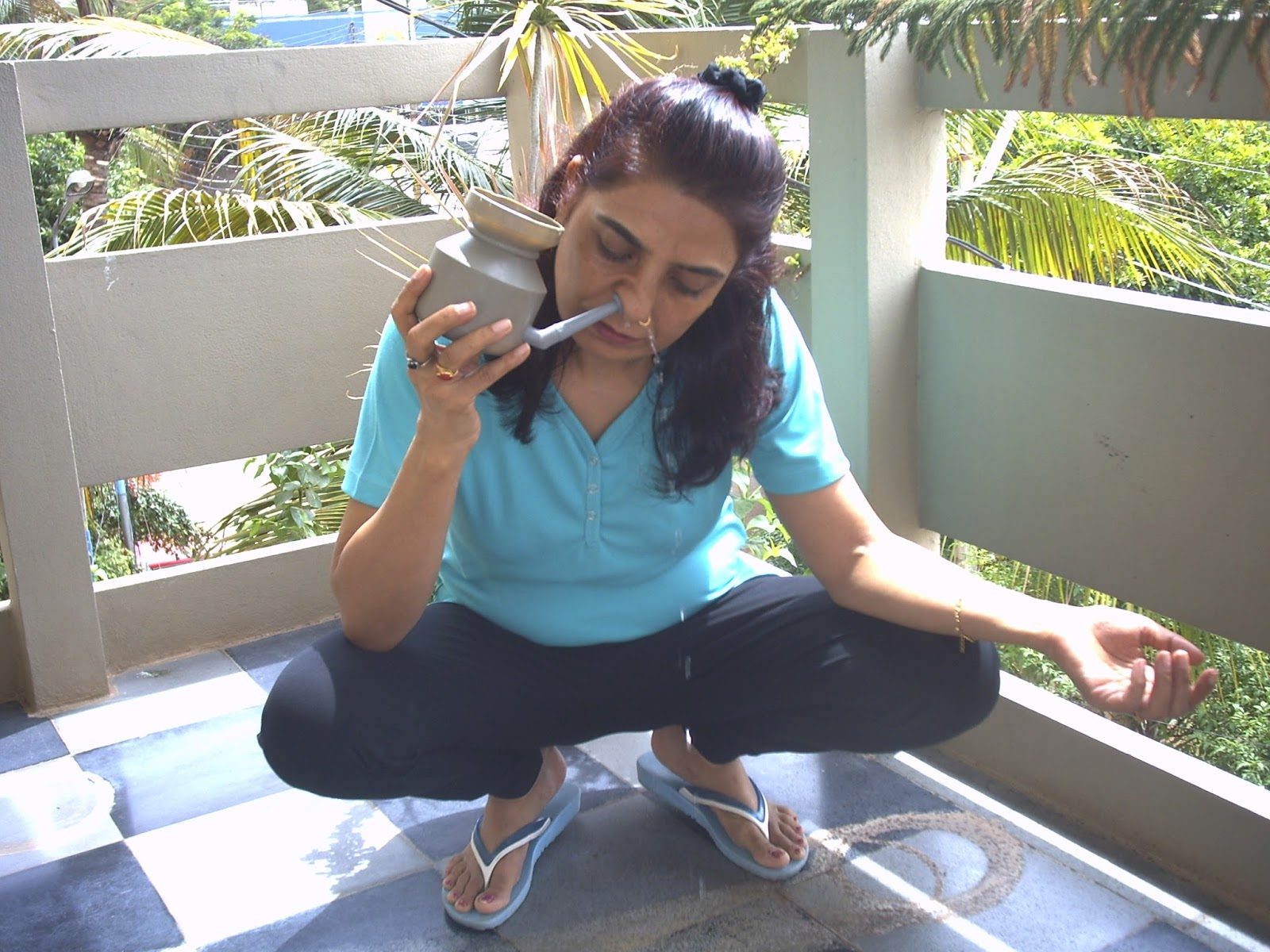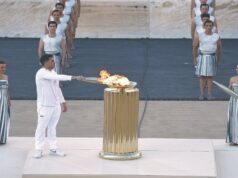By Dr. Rita Khanna
Yogic Approach to Phobic Anxiety


Phobic anxiety is characterized by fear of one’s own nature and is related to anxiety about how others will perceive us, reflecting our self-hatred. Anxiety states are a result of overstimulation of the autonomic nervous system (ANS). The limbic and psychic centres in the brain are highly sensitive to emotional states such as fear.
They in turn stimulate the hypothalamus which triggers the ANS and endocrine system to respond to the threat. The parasympathetic and sympathetic nervous systems which control the automatic processes of the body, such as digestion, respiration, blood pressure, etc. are thrown into an imbalanced state because the sympathetic nervous system is stimulated and hormones are secreted (thyroxin from the thyroid and adrenaline from the adrenals).
Long term imbalance in the autonomic nervous system and endocrine system caused by high levels of panic and anxiety also lead to exhaustion and depression and can result in lowered immunity as in conditions such as Chronic Fatigue Syndrome.
PHOBIC ANXIETY
There are three broad groups of phobias:
1. ORDINARY OR SIMPLE PHOBIAS
Fear of a cockroach or a lizard, fear of a closed space, fear of loneliness, fear of height and when some animal is seen.
Below is an example of great Napoleon Bonaparte:
Napoleon was one of the greatest military commanders in history. A wild cat had jumped over Napoleon Bonaparte when he was quite young. Even when he reached adulthood the fear that had got into him during childhood was still prevalent. Once the enemy camp learnt about this personal phobia of such an adept soldier who was habituated to fight many a terrible wars, they kept in the forefront of their army 500 cats tied with chains. On viewing these cats Napoleon started retreating, he was caught, he lost the battle and ultimately met his death.
Some children form a phobia for certain animals. Such children even when they become adults are not capable of driving away that phobia which had entered their child like mentality because their adult mind does not drive out the fear that has entered their nervous system.
2. AGORAPHOBIA
Agoraphobics tend to be introverted, cannot bear big crowds. Public transport and vehicular traffic as well as deep noises in the market place are intolerable for them. Under such circumstances they get afraid of getting caught, entangled and entrapped as well as getting confused. They have difficulty expressing their feelings and communicating their needs and desires, especially anger and frustration.
Agoraphobia mainly affects adults. This type of fear can be observed in persons who have matured.
3. SOCIAL PHOBIAS
The third type of phobia is arising out of incapacity of speaking or acting in public or in community meetings. It develops in adolescence and the person is concerned about shameful, stupid or inept acts. Extreme feelings of shyness and self-consciousness build into a powerful fear. As a result, a person feels uncomfortable participating in everyday social situations.
Amongst people who are affected by phobia, agoraphobia is observed in majority. The form of agoraphobia is quite different from the normal fears. In all the societies, whether from the east or the west, 5 to 10 percent of the people are found to suffer from one or the other phobia. This agoraphobias or any other type of phobia is more common amongst ladies than amongst males. Agoraphobia, social phobia and animal phobia are commonly found amongst members of the same family.
SYMPTOMS
Physical symptoms include: chest pain, palpitations, drop beats, flushing, feeling faint, sighing, choking, yawning, dyspnoea, dry mouth, ‘butterflies’ in stomach, nausea, abdominal pain, diarrhoea, frequency/hesitancy of urination, sexual dysfunction, tension headaches, blurred vision, sweating, ringing in the ears, shaking, dilated pupils, teeth clenching and chronic jerks.
Psychological symptoms include: feelings of impending disaster, worry, inability to relax, not being able to cope, restlessness, sense of ‘not being yourself’, insomnia, nightmares, depression and panic attack. Some of these symptoms are also experienced in chronic ongoing anxiety or stress. The person often believes in having a physical condition such as heart disease, and this contributes to the anxiety.
CAUSES
Inherited disposition, childhood experiences and conditioning, and may be related to conditions where the functioning of the brain is somewhat impaired.
A psychoanalytic perspective suggests that the anxiety response in phobias is not to the object or the event itself, but to the possibility that some unacceptable unconscious material is about to erupt into consciousness.
Phobias are, therefore, understood as a result of repression: when the repressed event or content threatens to come to consciousness, the frontal passages of the brain are stimulated – the limbic and psychic centres – and a panic attack results. While the threat begins in the mind, the body responds as if it were real. Phobias thus illustrate the interdependence of the mind, body and the unconscious forces which shape our experience.
YOGIC APPROACH TO PHOBIC ANXIETY
Fear is a mental attitude. One has to strengthen and develop mental power to face any fearful situation. It is possible to achieve this by practicing Pranayama, Asanas, Meditation and Yoga-nidra since Yoga views and treats the mind, body, emotions and energetic systems as a whole. The regular practice of these balances the nervous and the endocrine systems and the Prana or energy in the body, bringing greater emotional and mental calm.
ROLE OF THE CHAKRAS AND NADIS
According to Yogic understanding, the body, mind and emotions are comprised of and sustained by Prana the subtle energy or force that creates all life. The energy bodies are linked in through the seven Chakras which correspond with nerve plexuses and the Nadis. If phobias are a product of repressed material, Yoga suggests that the combination of genetic and environmental impressions is stored in the Chakras, and in the flow or blockage of the Nadis. Over activity or under activity in the Chakras or Nadis causes disease.
• Mooladhara Chakra, at the perineum or cervix, is the site of these karmas and knots, and is also the location of our primal energy. When unbalanced, fear, insecurity, low vitality and self-esteem, depression and fear of the future result.
• Swadhisthana Chakra, at the coccyx/pubic bone, is related to the subconscious mind, pleasure and the repression of pleasure.
• Manipura Chakra, at the navel, is the site of all power, the desire to control, and self-assertion, and is related to the stomach and the adrenals.
• AnahataCchakra, the heart centre, and Vishuddhi Chakra, the throat centre, are related to love and communication respectively.
• Ajna Chakra, the eyebrow centre, controls the activity of the brain.
Speculating, we can say that a phobia probably involves at least Mooladhara – fear, anxiety, and Manipura – the desire to control the anxiety, the fear of fear and need to control that characterizes panic and anxiety states. Ajna Chakra, the site of mental worry and anxiety, is also involved, as are the heart centre – palpitations, and the throat centre – inability to speak. The unconscious fears at Mooladhara may be related to repression of primal energy or sexuality.
Of the Nadis, Ida and Pingala are the most relevant here. Ida is linked to the left side of the body and the right side of the brain, moving in the left nostril, while Pingala controls the right side of the body and left side of the brain and moves in the right nostril. Ida and Pingala meet and cross at each of the Chakras which are linked by Sushumna moving in the central spinal column. Unhealthy Ida results in introversion, depression and paranoia, and ongoing mental tensions, while unhealthy Pingala is related to lack of exercise, sedentary lifestyle and overeating. Since Ida relates to the parasympathetic nervous system and Pingala to the sympathetic nervous system, an imbalance in these Nadis will reflect an imbalance in the systems, as in panic attack.
ASANAS
Surya namaskara is of great benefit for all anxiety states because it works to balance the entire body and endocrine system. Shashankasana, Marjariasana, Ushtrasana, The Trikonasana series, Chakrasana and Dhanurasana work on the adrenals. The Shakti Bandha series, Spinal twists, Paschimottanasana and Bhujangasana are also recommended. The inverted poses- Sarvangasana, Vipareeta karani Mudra, Halasana and Shirshasana can be practised by the more experienced student.
PRANAYAMAS
The practice of Shitali and Sheetkari Pranayama brings mental peace and capa¬bility. Ujjayi, the ‘psychic’ breath, brings stillness, clarity and calm. Bhramari, the humming breath, is useful to alleviate mental tensions and worries. Nadi shodhana is especially beneficial because it works directly on the Nadis, purifying the Pranic system and bringing the whole body into balance. Bhastrika revitalizes the sympathetic nervous system while Kapalbhati tones the parasympathetic nervous system.
YOGIC KRIYAS
Kunjal is especially beneficial for releasing tensions held in the Manipura area. Neti and Shankhaprakshalana are soothing and work to tone and balance the body. Kapalbhati Kriya works to remove impurities and makes the mind calm, while Trataka, working on Ajna chakra, influences the pineal gland, the hypothalamus and the sympathetic nervous system.
MEDITATION
By a regular practice of meditation we inherit fearlessness and self-confidence. There is one simple formula. Whenever you sit for Meditation, before beginning the process, pray, “Let there be peace in the east, in the west, in the north, and in the south. Let all meet auspiciousness in mountains, ocean, and forests. Let there be welfare of all, everywhere.” Thereafter think that you are not meditating. Who is the entity for your medi¬tation? Suppose you are meditating on Shree Rama, in that case always think that Rama himself is meditating on Rama. This is not your body this body belongs to Shree Rama. The legs, hands, belly, chest, neck, head nothing belongs to you. All these belong to God. This process is called “Anga¬nyasa and Kara-nyasa”. If you are given any Guru mantra, repeat the same. The more regular you are in Japa, the more the manifestation of God’s power, strength and domi¬nation in you. You earn the boon of Grukrupa (God’s Grace) through the power of Japa. Japa, Meditation, company of the wise, study of scriptures, company of good and strong-minded persons will make you strong.
YOGA NIDRA
Yoga- nidra is probably the most powerful practice in the long term treatment of phobias and extreme anxiety. It acts as a ‘tranquilizer’ to balance the hypothalamus and relieve anxiety states. Most importantly, the regular practice of Yoga- nidra gives access to the deep unconscious and subconscious forces which are the basis for the phobia and allows them to be released. In the advanced stages of Yoga -nidra, practitioners are asked to submit voluntarily to threatening emotions while preserving a state of deep relaxation and ‘witness awareness’ to the whole process. A specific program of Yoga -nidra, beginning with the basic technique and continuing into specific guided visualizations, should be constructed, with a teacher who can guide the person through this process.
A TECHNIQUE OF SUKHPURVAKAPRANAYAMA TO DEVELOP MENTAL POWER
• Sit in Padmasana, Siddhasana, Vajrasana or Sukhasana, keeping the back and spinal column erect. However, if you cannot sit in any of the above postures, you can sit in a chair or you can even lie on the ground.
• Begin by deep inhalation through both the nostrils. Thereafter exhale through both the nostrils slowly and without any fear. Do not use any force while inhaling as well as exhaling. This process is all right to begin with. It is not necessary nor there is any need to count the number of respirations. Breathe in and breathe out peacefully, without any sort of haste and as quietly as possible.
• Thereafter try to retain the breath inside. Inhale through both the nostrils and hold the breath inside. Thereafter exhale peacefully through both the nostrils and hold the breath outside.
The inhaling is called Purak, the holding of breath is called Kumbhak and the exhaling is known as Rechak. The breath that we hold inside is called Antar-kumbhaka and the breath, which we exhale and stop it outside, is called Bahya-kumbhaka.
• The rule for the period to be observed in Purak, Kumbhak, Rechak and Kumbhak are 1:4:2:4. Do not worry if the process is not possible to begin with. Be satisfied with inhaling and exhaling.
• Every inhalation brings in some newness, energy, vitality alertness, joy and enthusiasm.
• Every exhalation makes you one with the Almighty power of the universe.
SOME MORE IMPORTANT POINTS
• Feel that you are not alone. The whole world is connected with you. There is no reason to be afraid. Even if we sit at one end of a quiet pond and start splashing, the waves will travel to farthest end. The light touch at one end of the pond is felt at the other end.
• When you start feeling that you are afraid, drive out the thought from your mind that you are all alone. Even when you do not feel any fear always hold a powerful thought in your mind. “I am infinity I am joy incarnate. I am great”. Almighty is the only truth. The creator of the universe is God. He is beyond time, He is everywhere, He is present in everything and He is all-powerful. Therefore live, throwing off all the phobias, live happily.
• Fear can be reduced if a fearing person is brought out amongst the society by moving him away from lonely life and by slowly making him accustomed to meet and mix with people in the society.
• The fear could also be reduced by making him form a habit of taking a stroll under the open sky, at night under the stars studded night, along the river banks, along the streams and in gardens full of flowers.
• Always remember, you are your own friend and your own enemy Fear is not outside, it is inside you. Never underrate yourself. Virat Purusha resides in you. He is a fountain of great power. The ocean of joy is rising in big waves. You have in you a fountain of enthusiasm. Manifest it by meditation and be fearless.
• Besides the above, get up early in the morning. Go for a long walk before sunrise. You will be filled with nature’s fresh power by the effect of open air, open blue sky, the chirping of birds and the exhilarating atmosphere.
A man who entertains fear for particular things can be repeatedly brought near that item and explained that his fear is ill placed and there is nothing in that item worth any fear.
One day Swami Vivekanandaji was loitering at Varanasi in an uninhabited area. A group of monkeys followed him. He was afraid and started running away One Sash on seeing him running called out, ‘Don’t be afraid, stop, present a strong front, if you get afraid they will try to make you more fearful”.
CONCLUSION
A Yogic approach to therapy for phobias and related anxiety states offers real benefits to the affected. Yoga shifts the emphasis from the external environment to the inner attitude, and from ‘fixing’ the mind or ego to a systemic transformation. Finally, it empowers the person to become his own healer, teacher and psychoanalyst!



